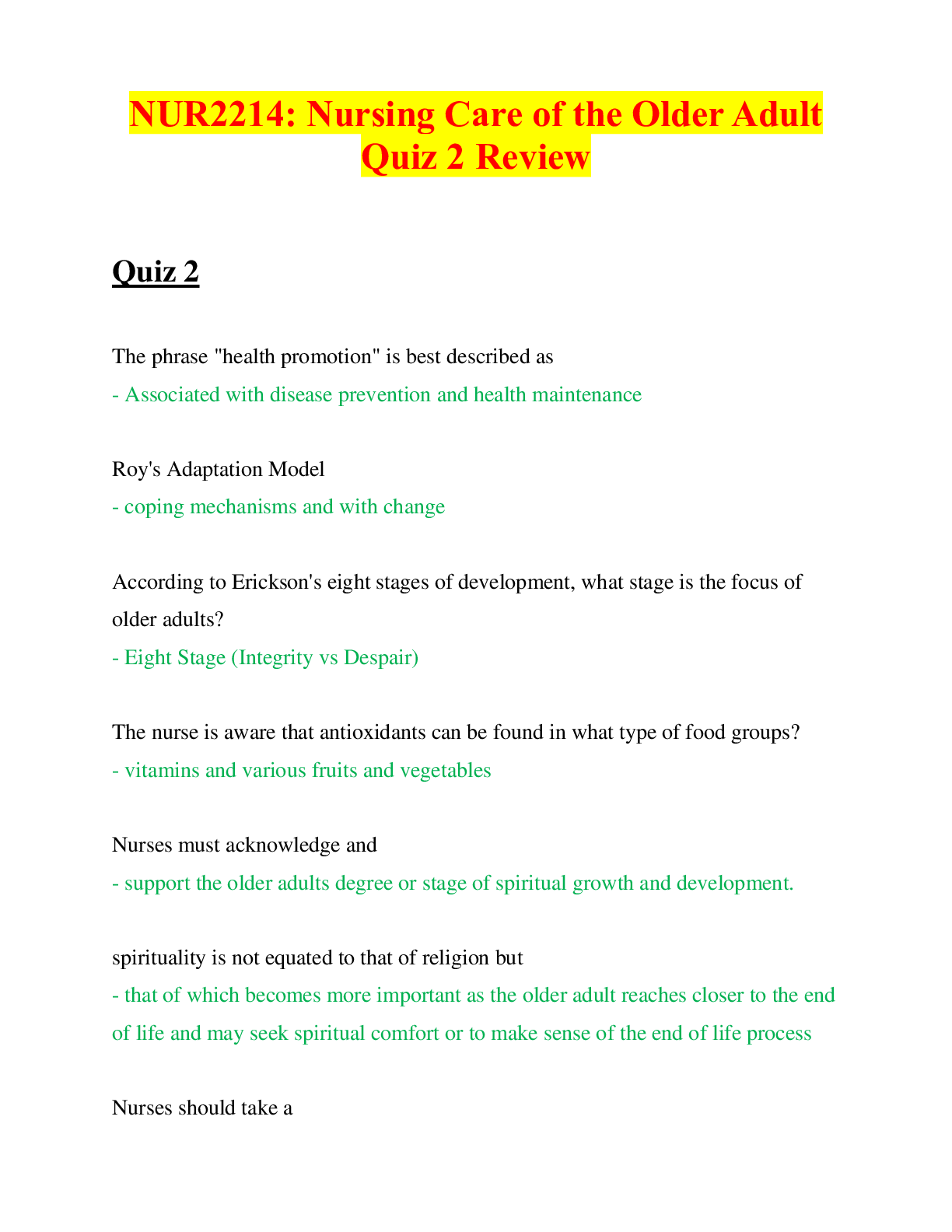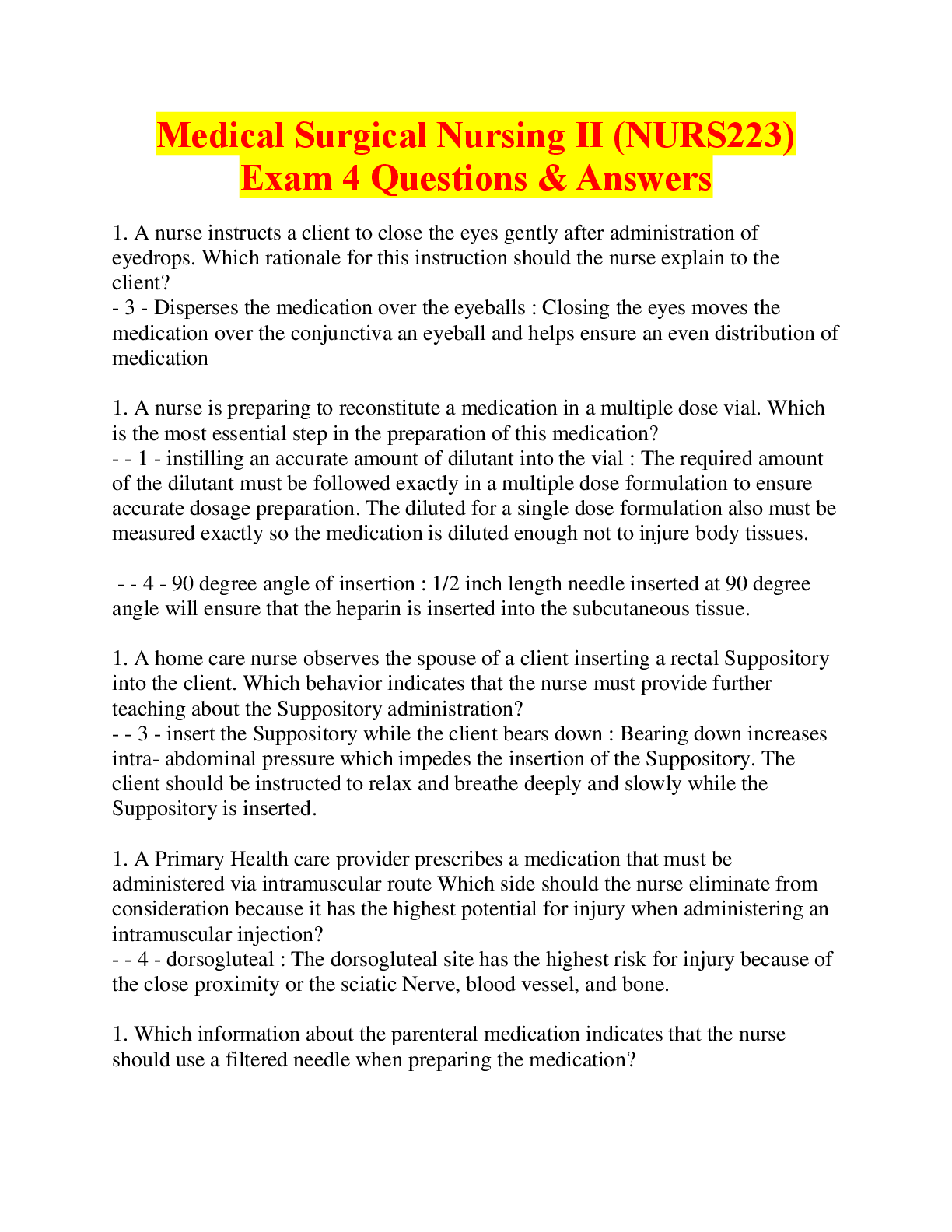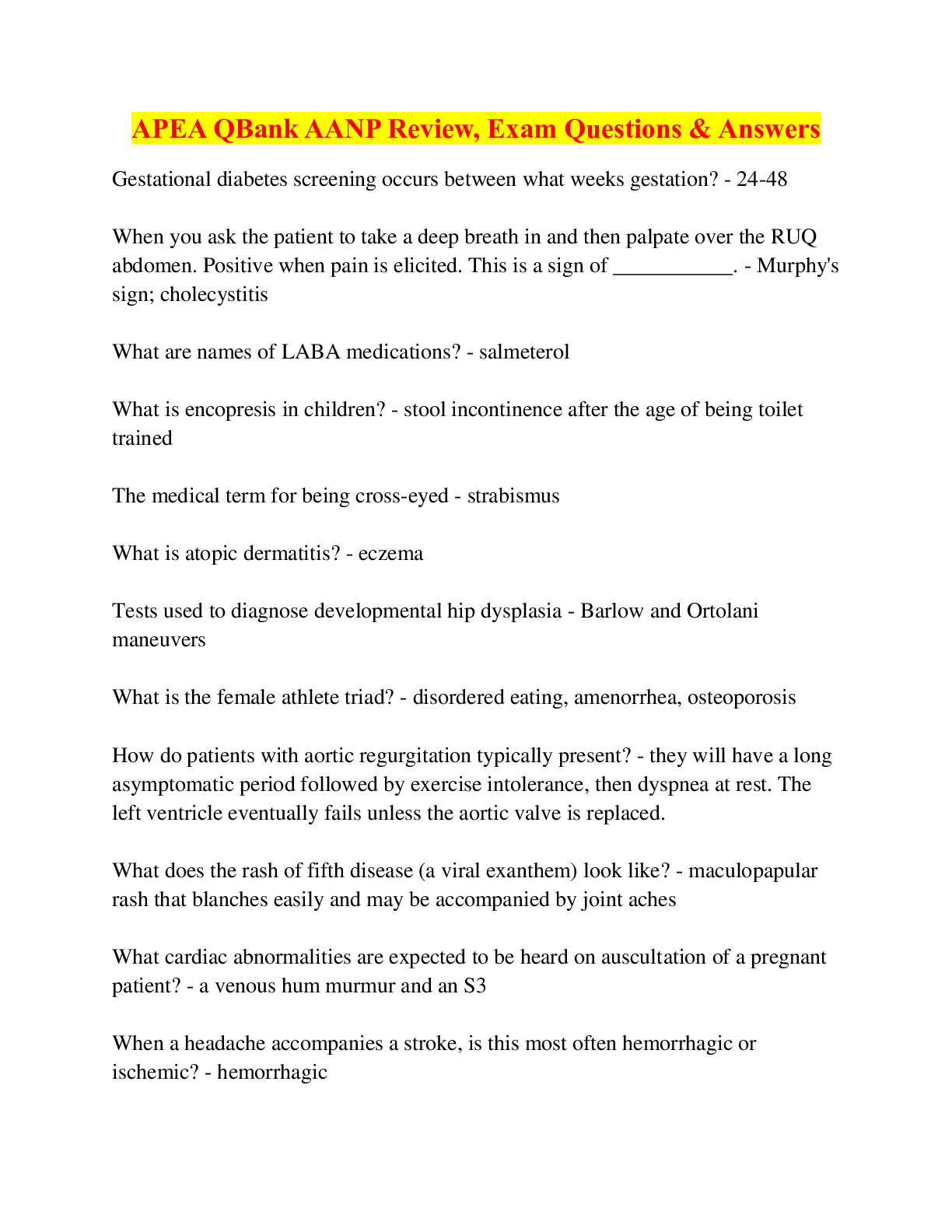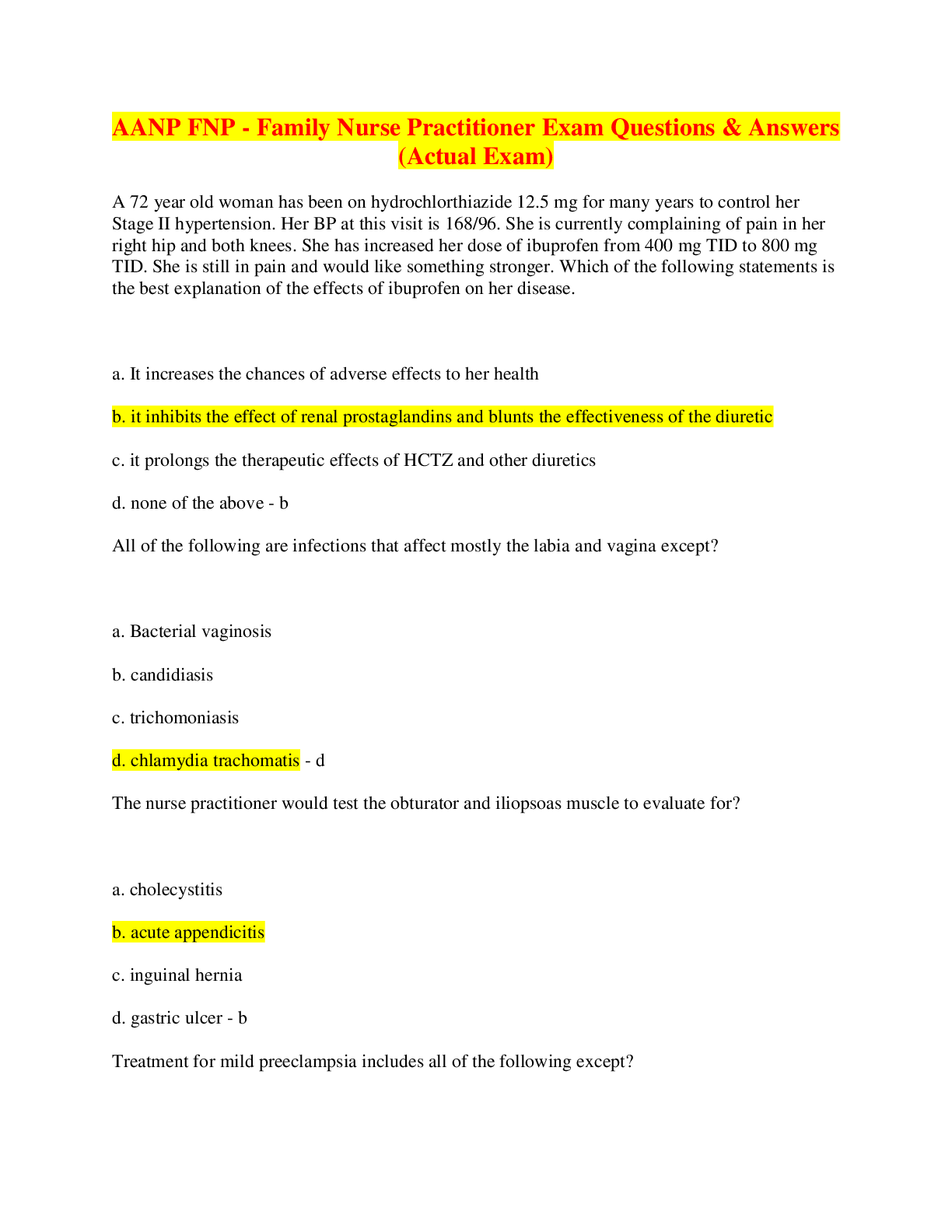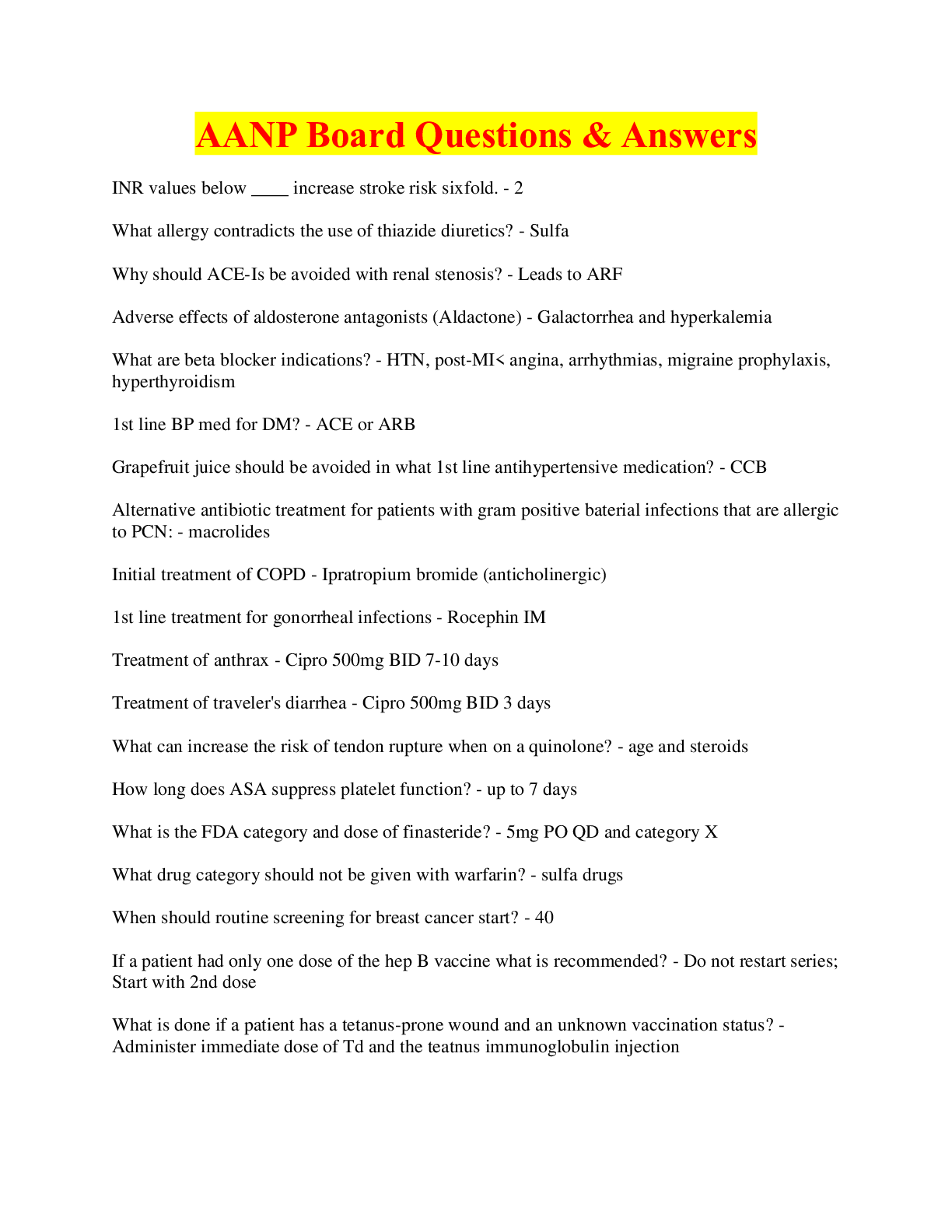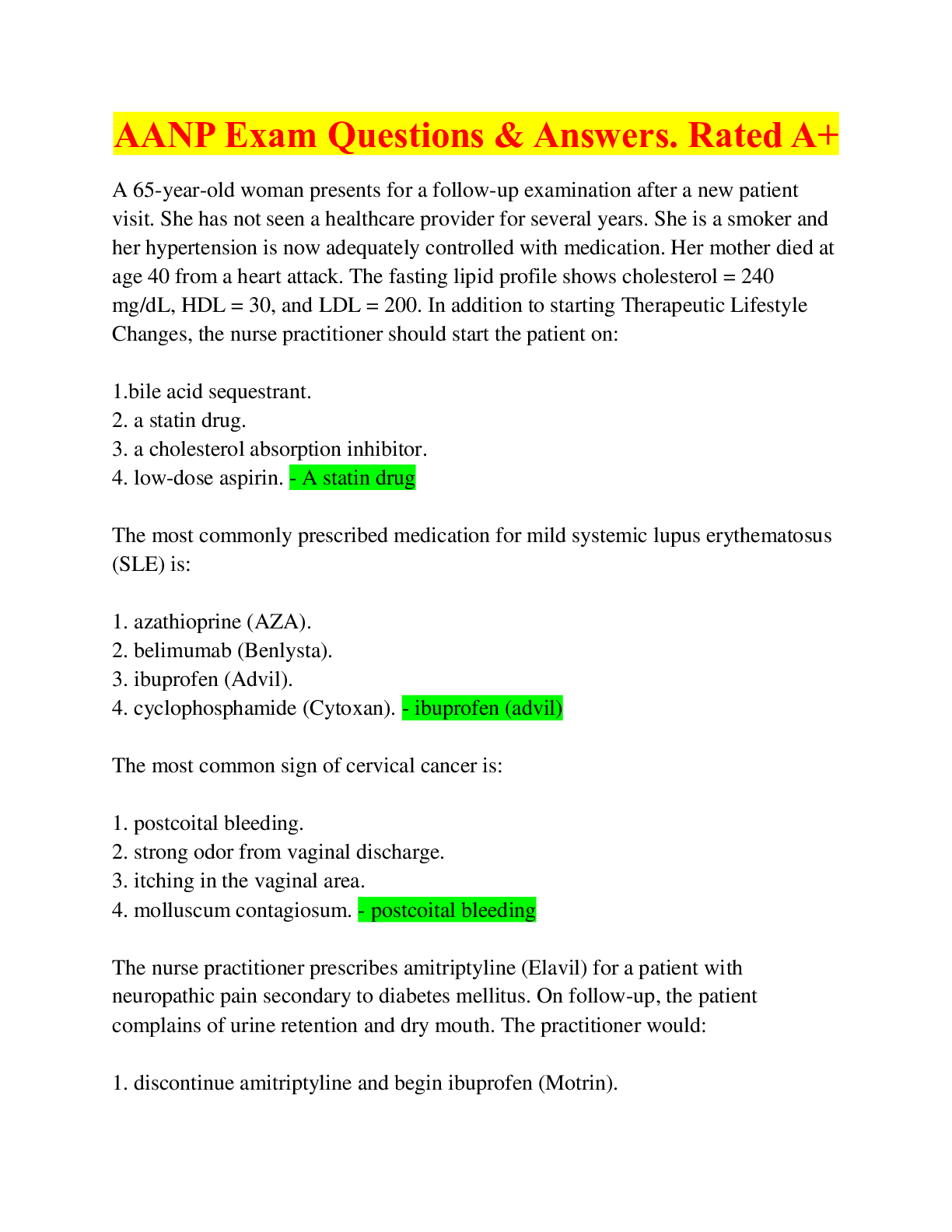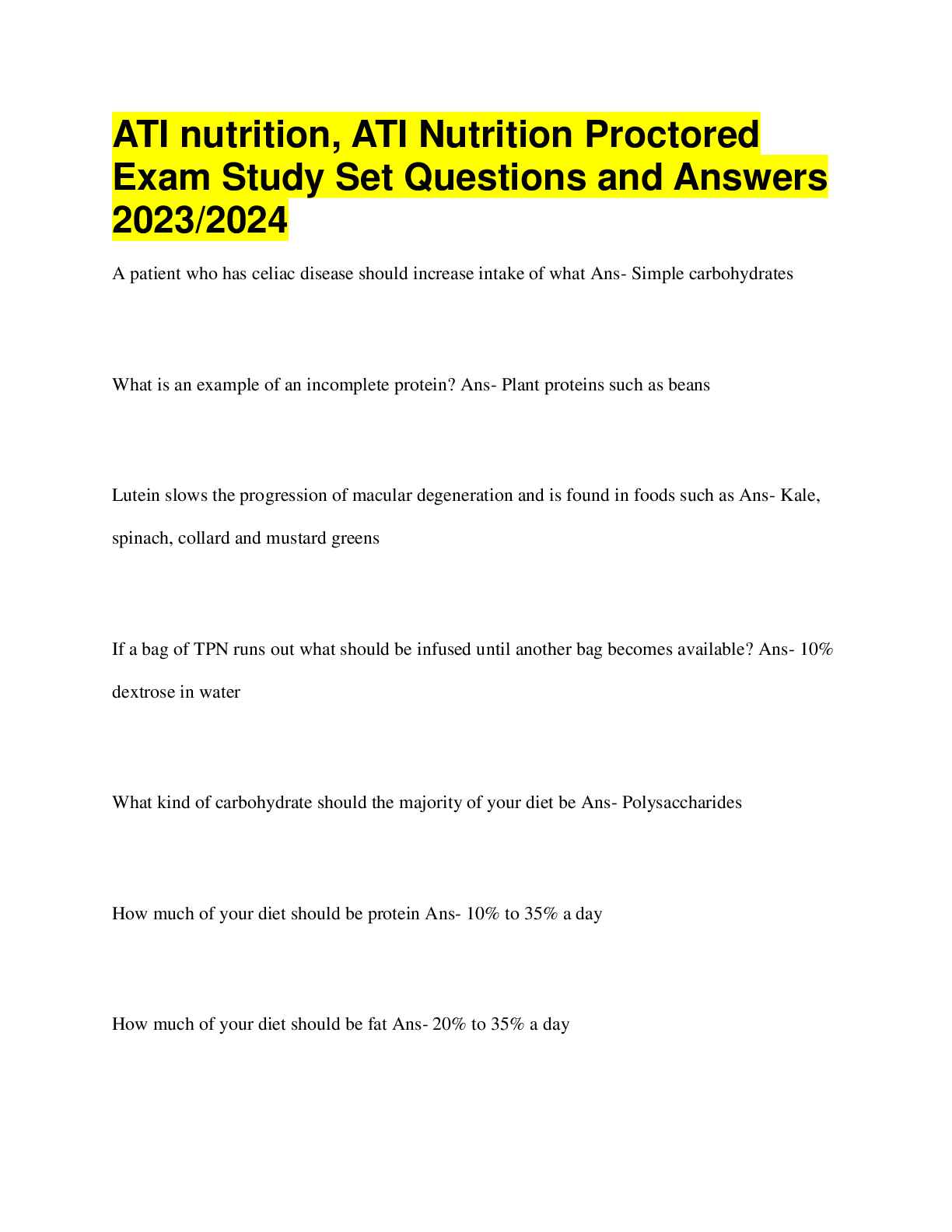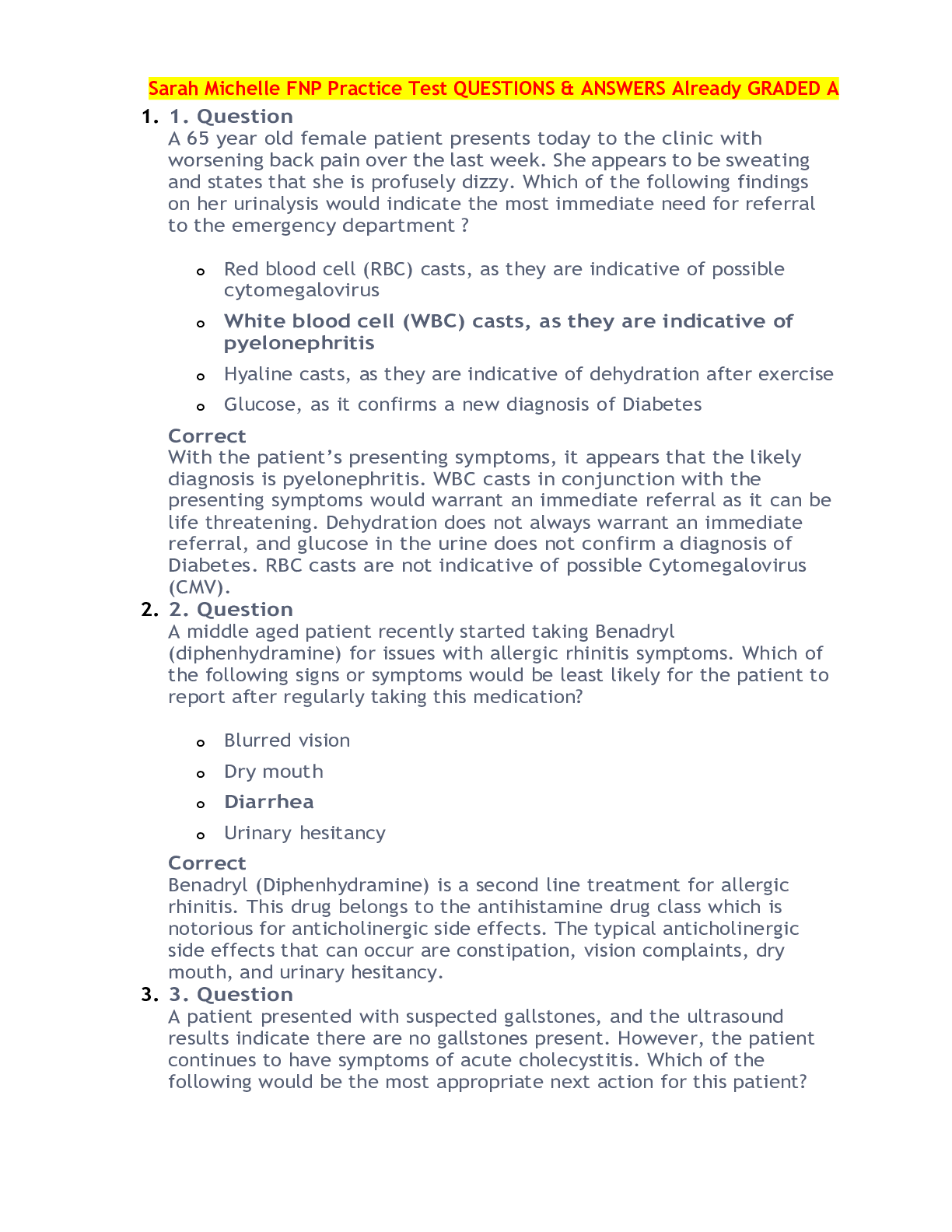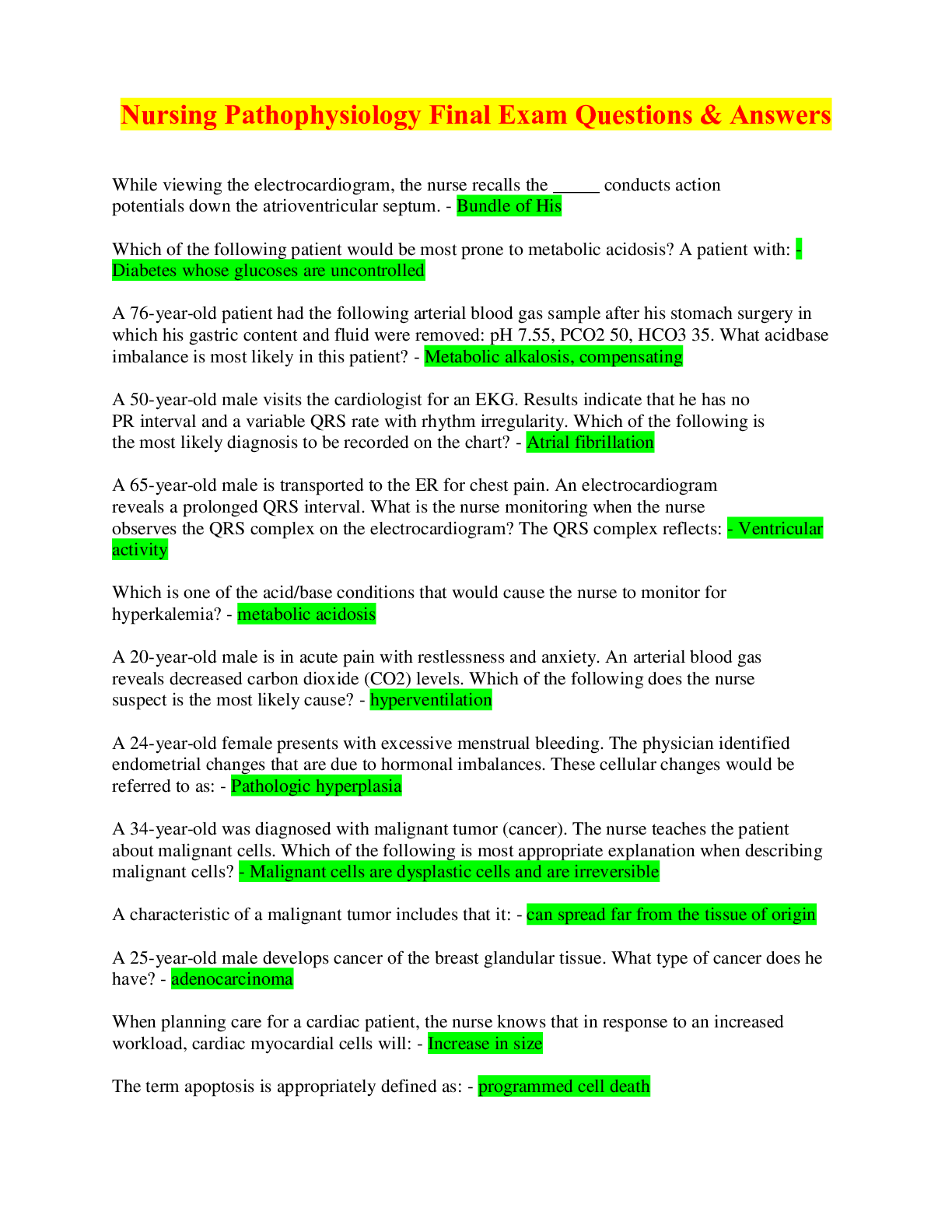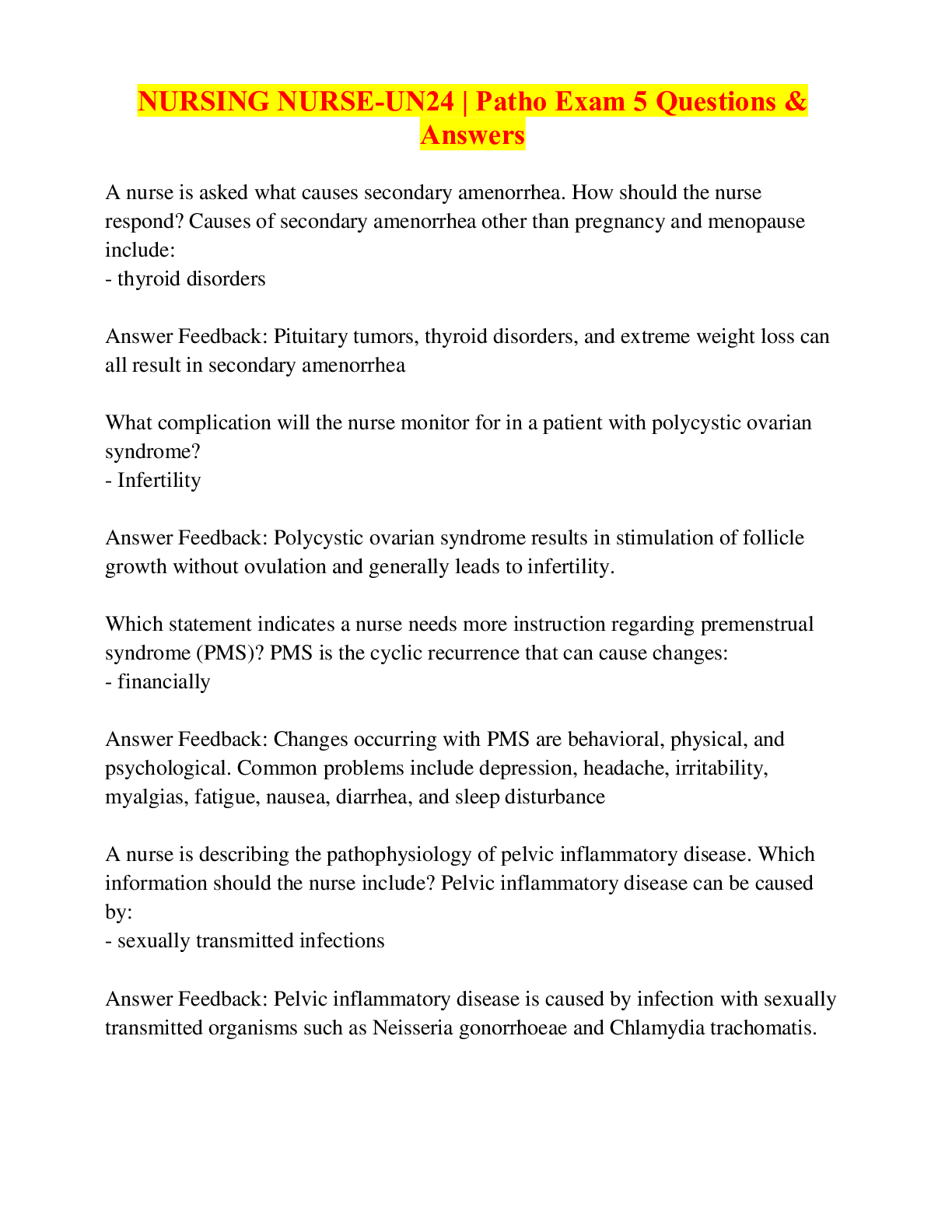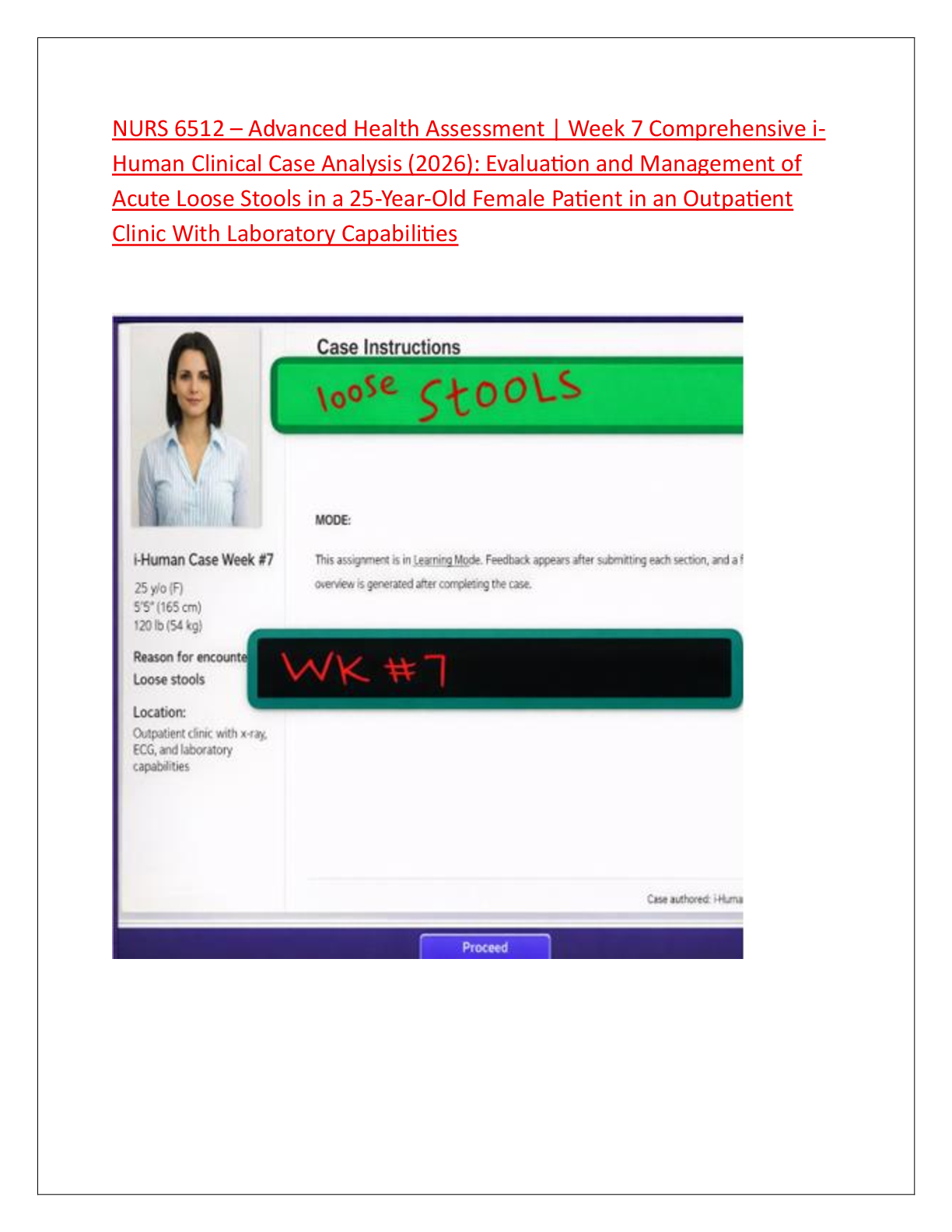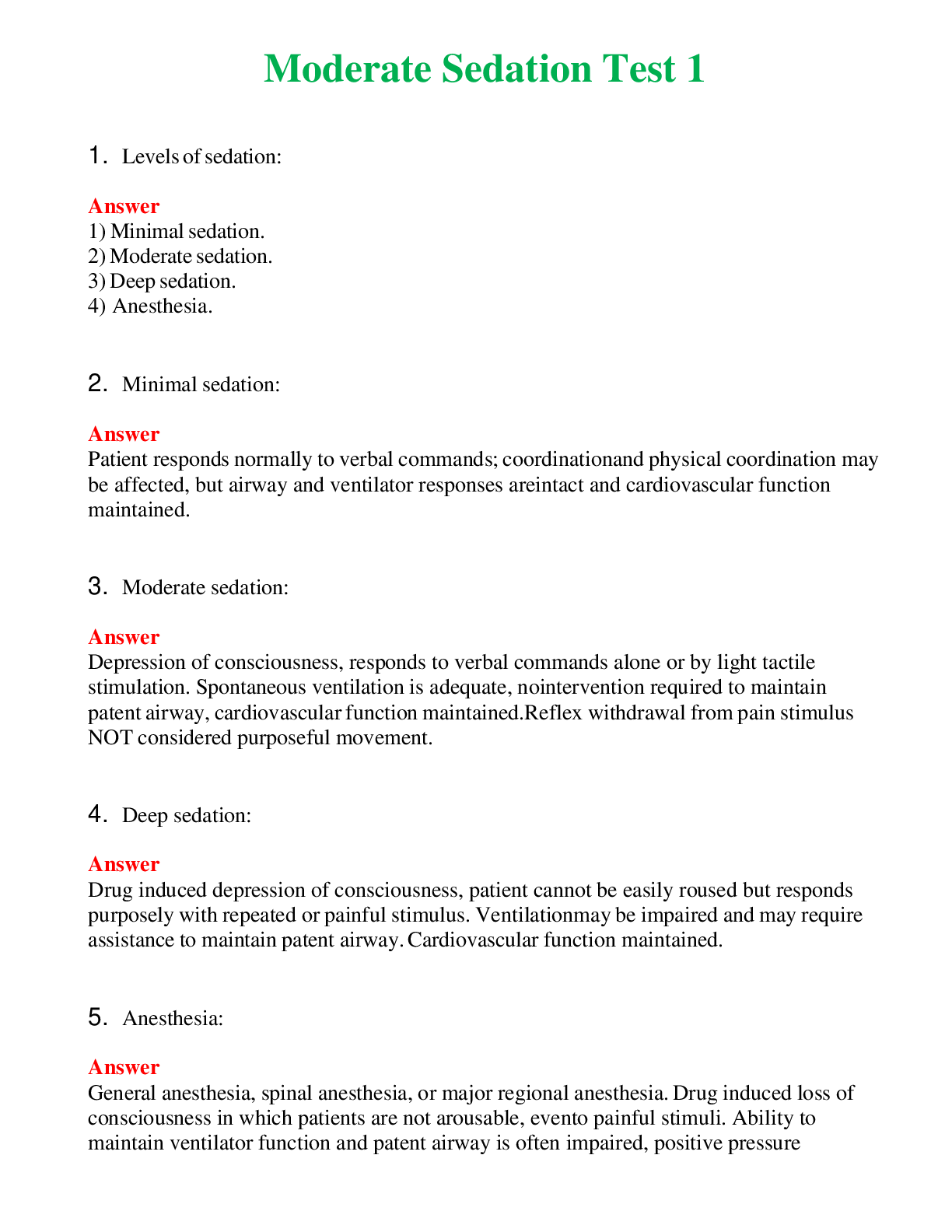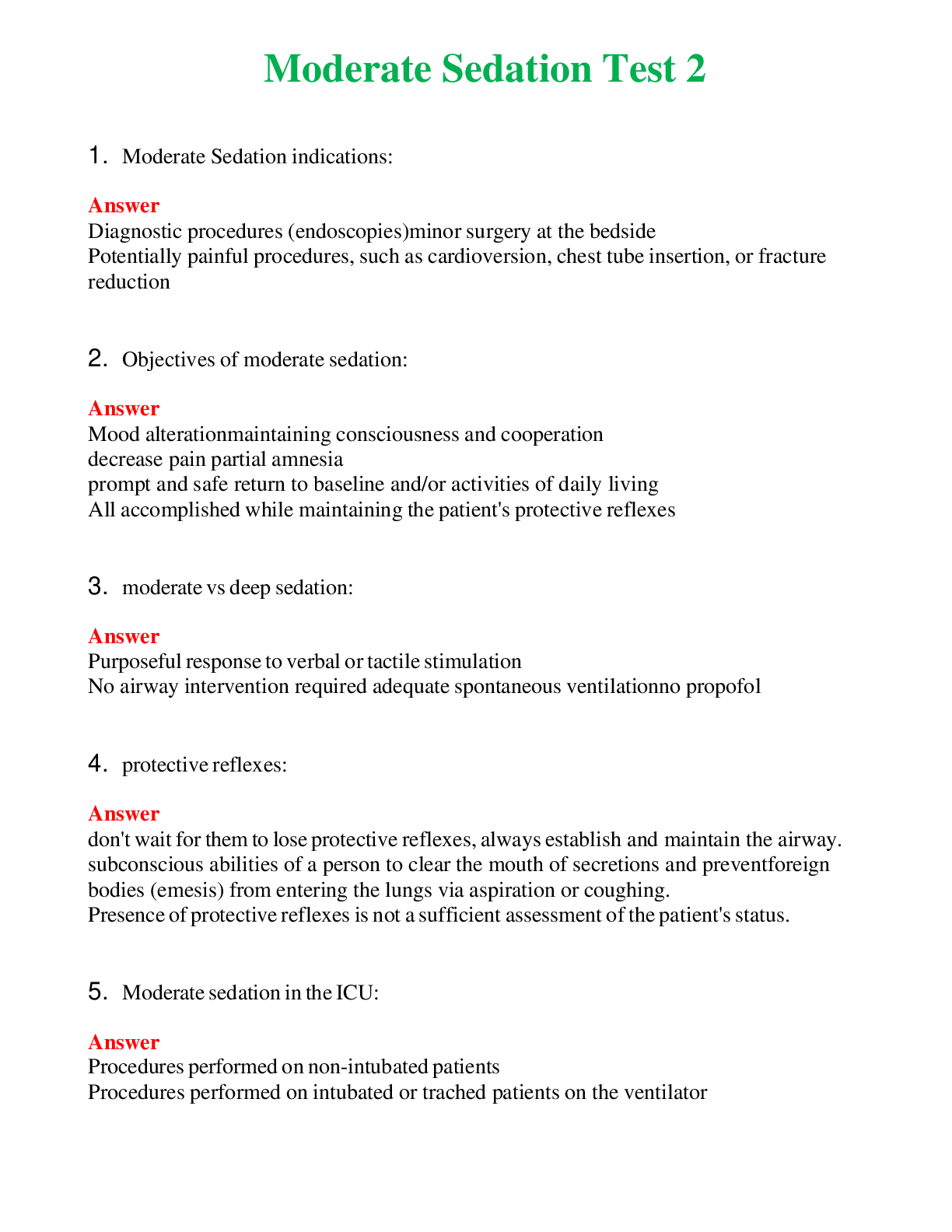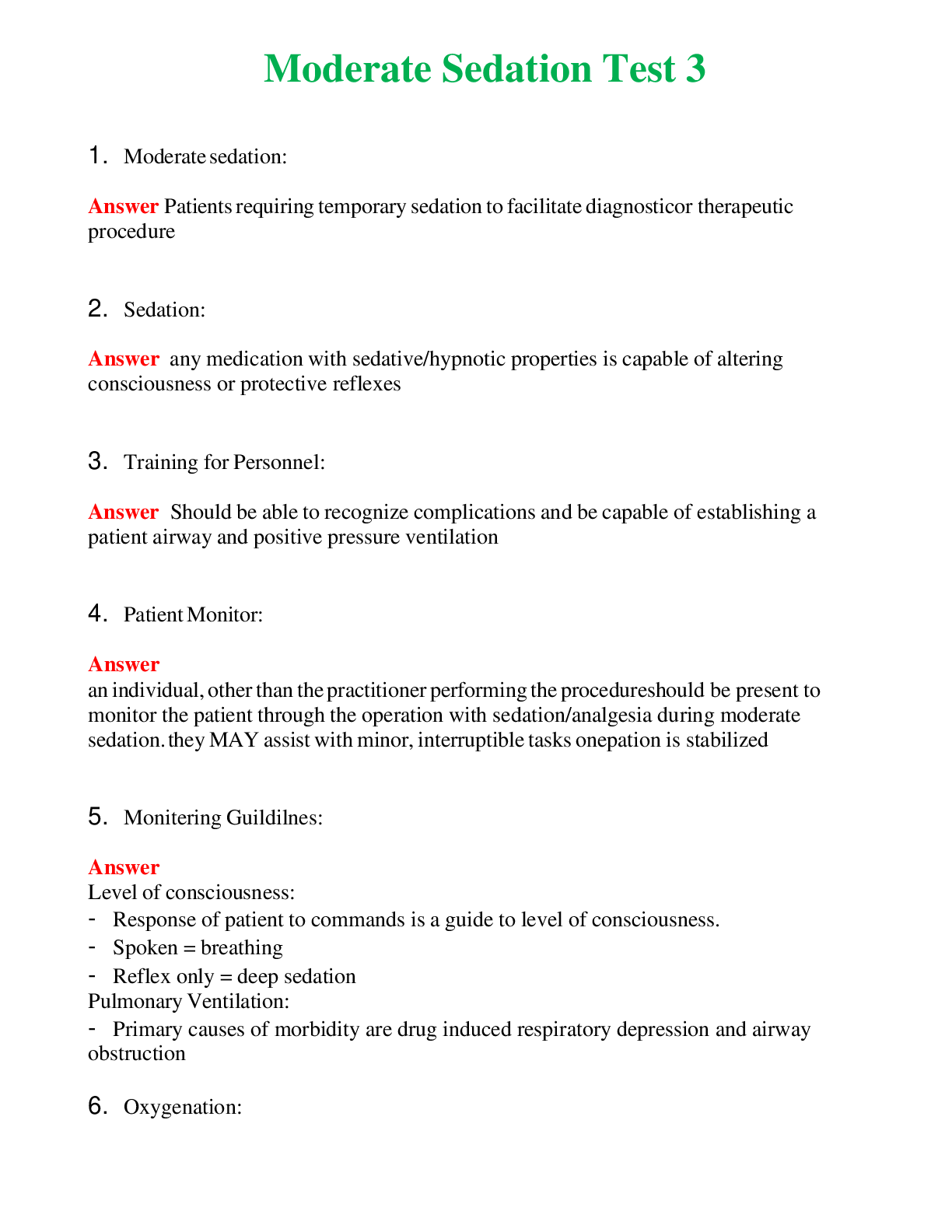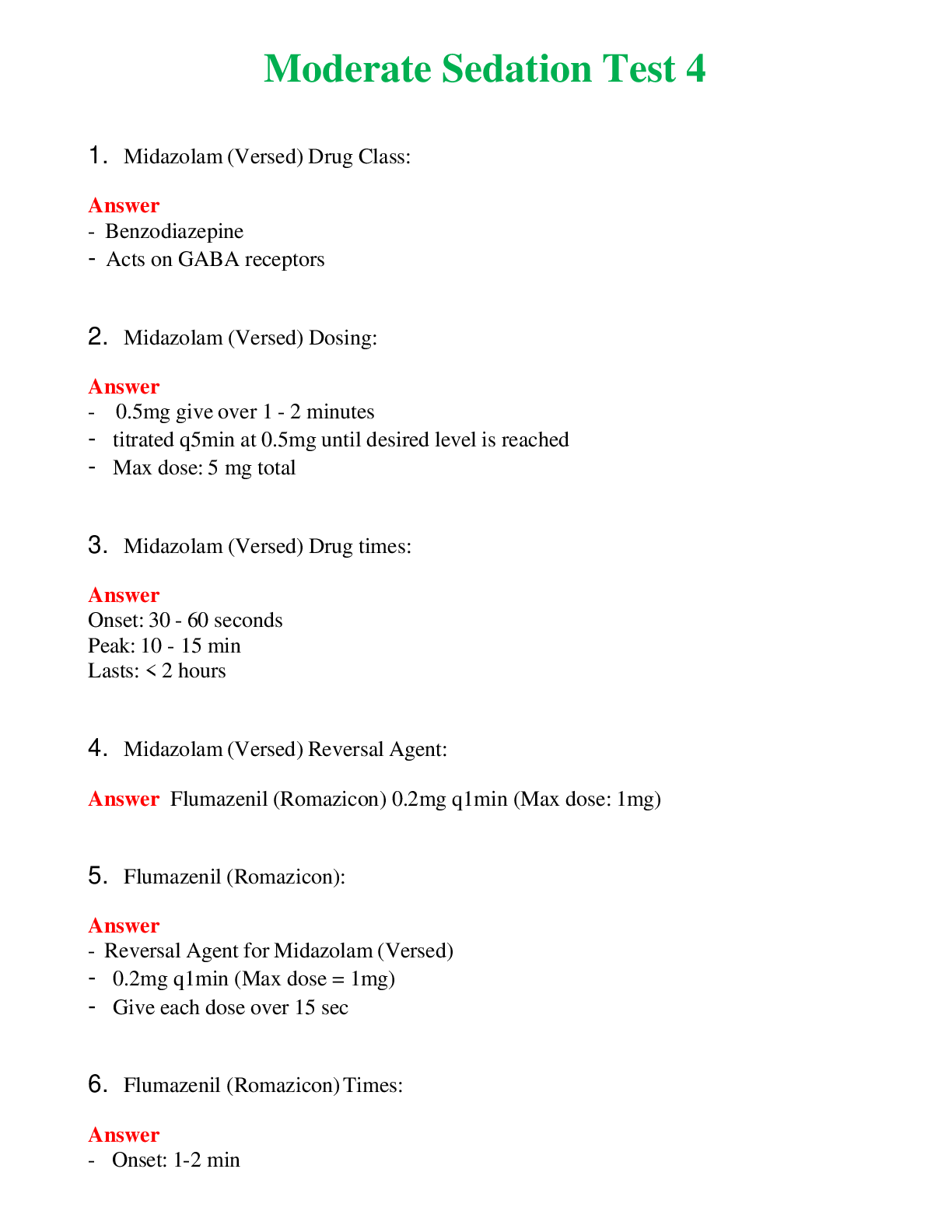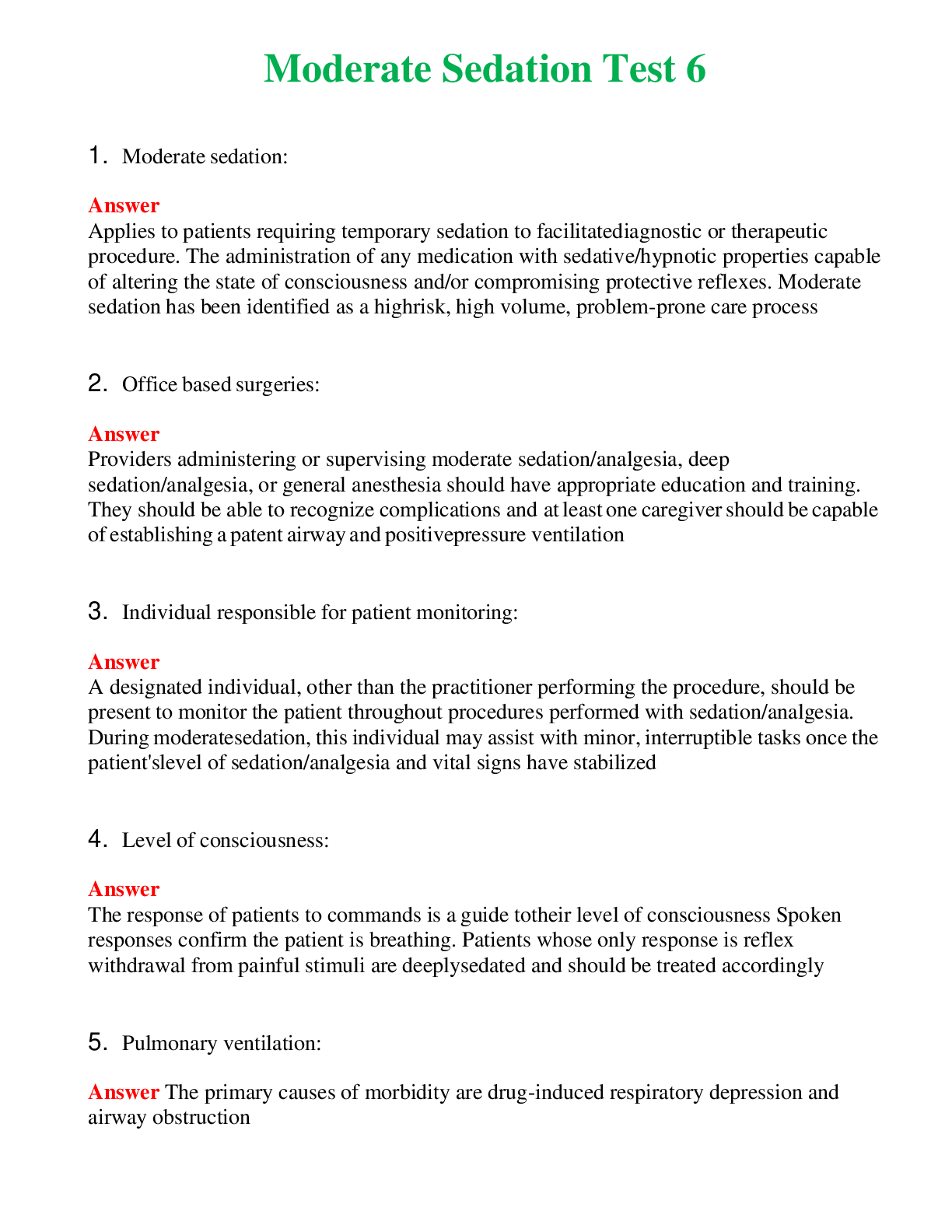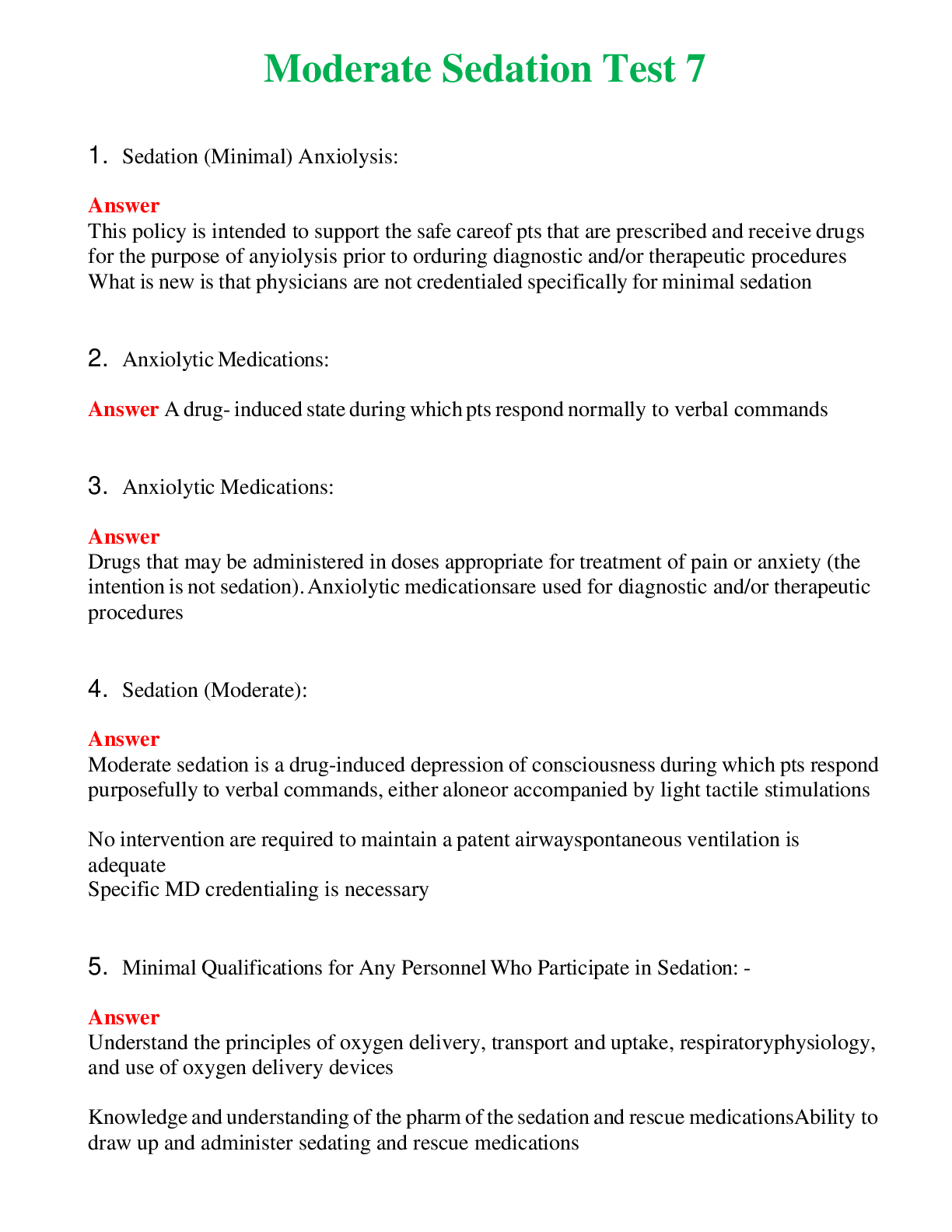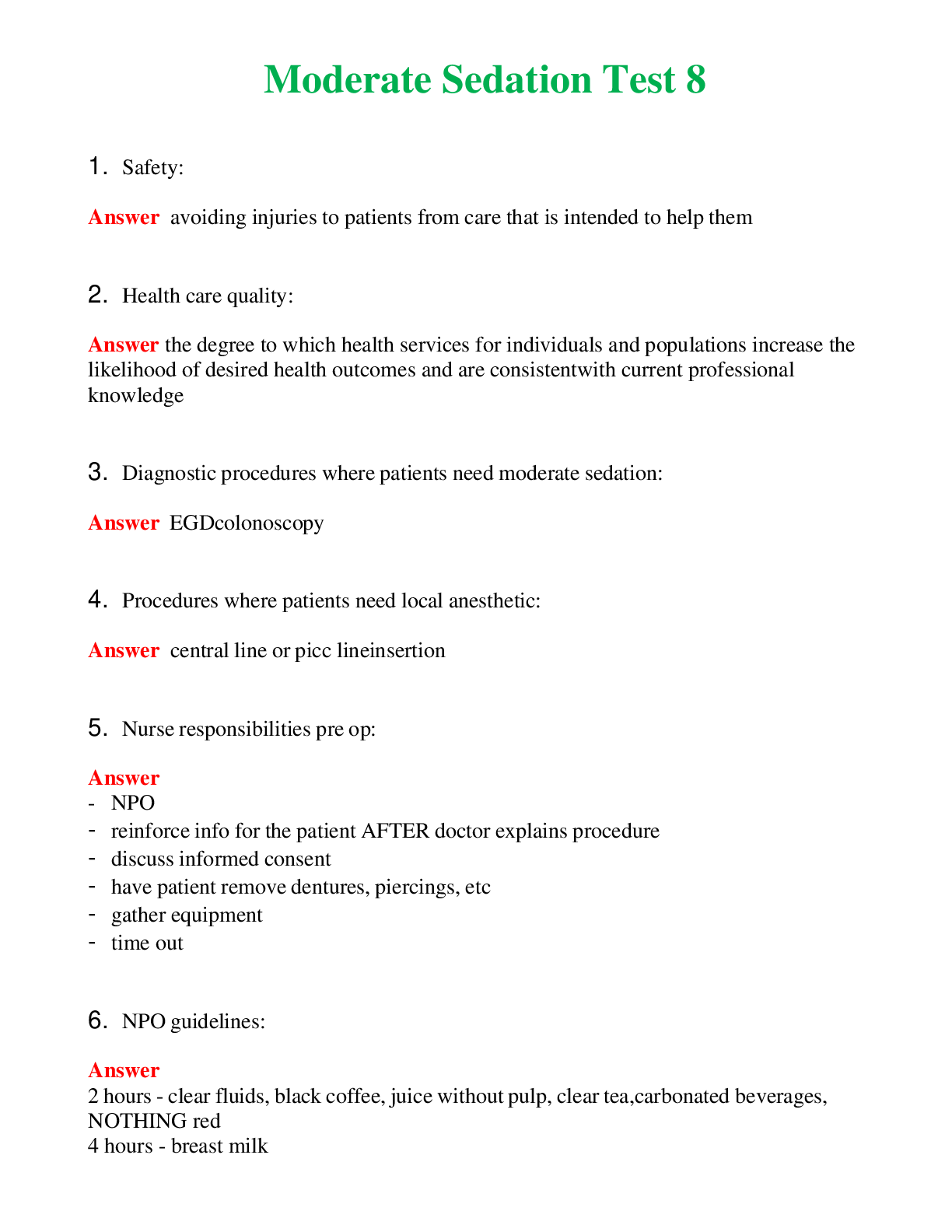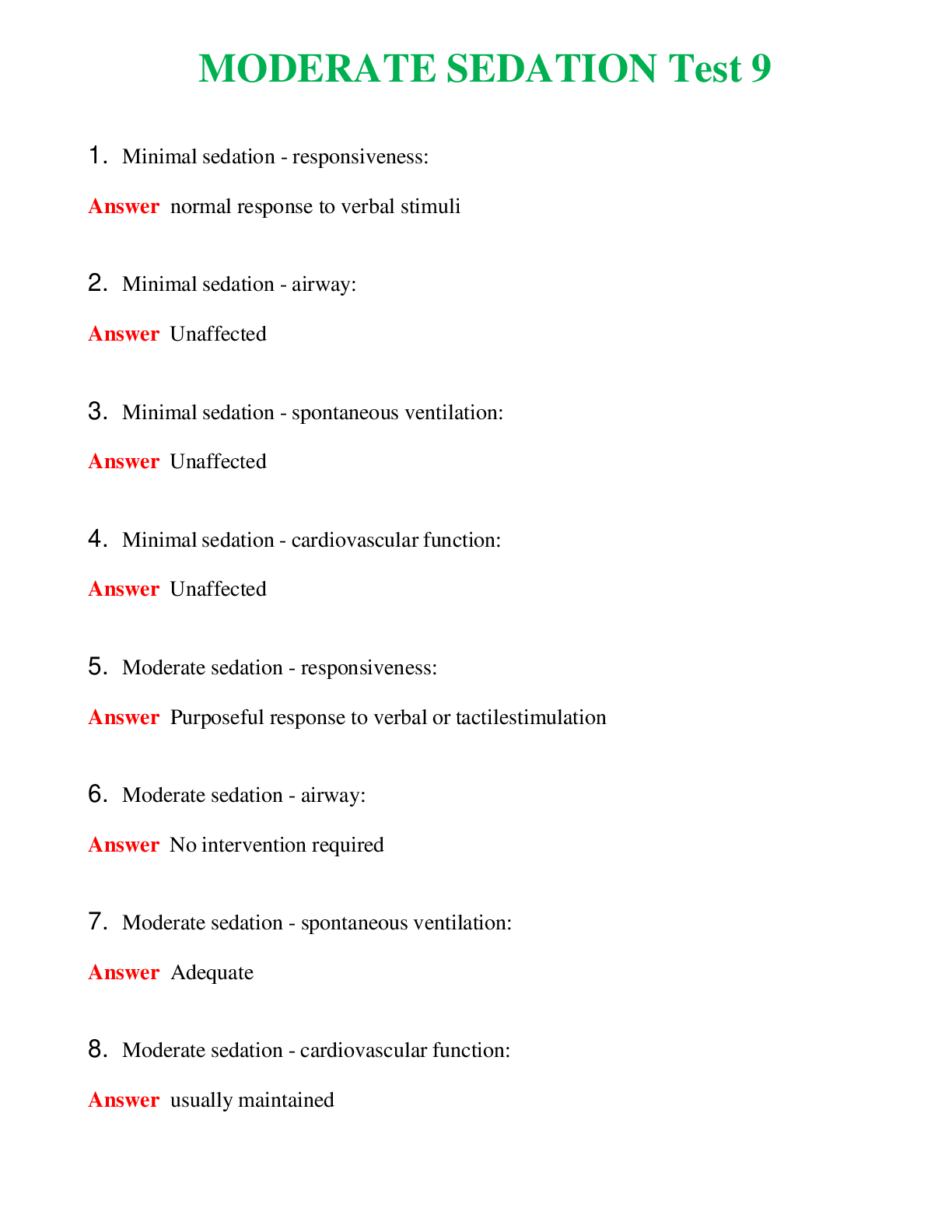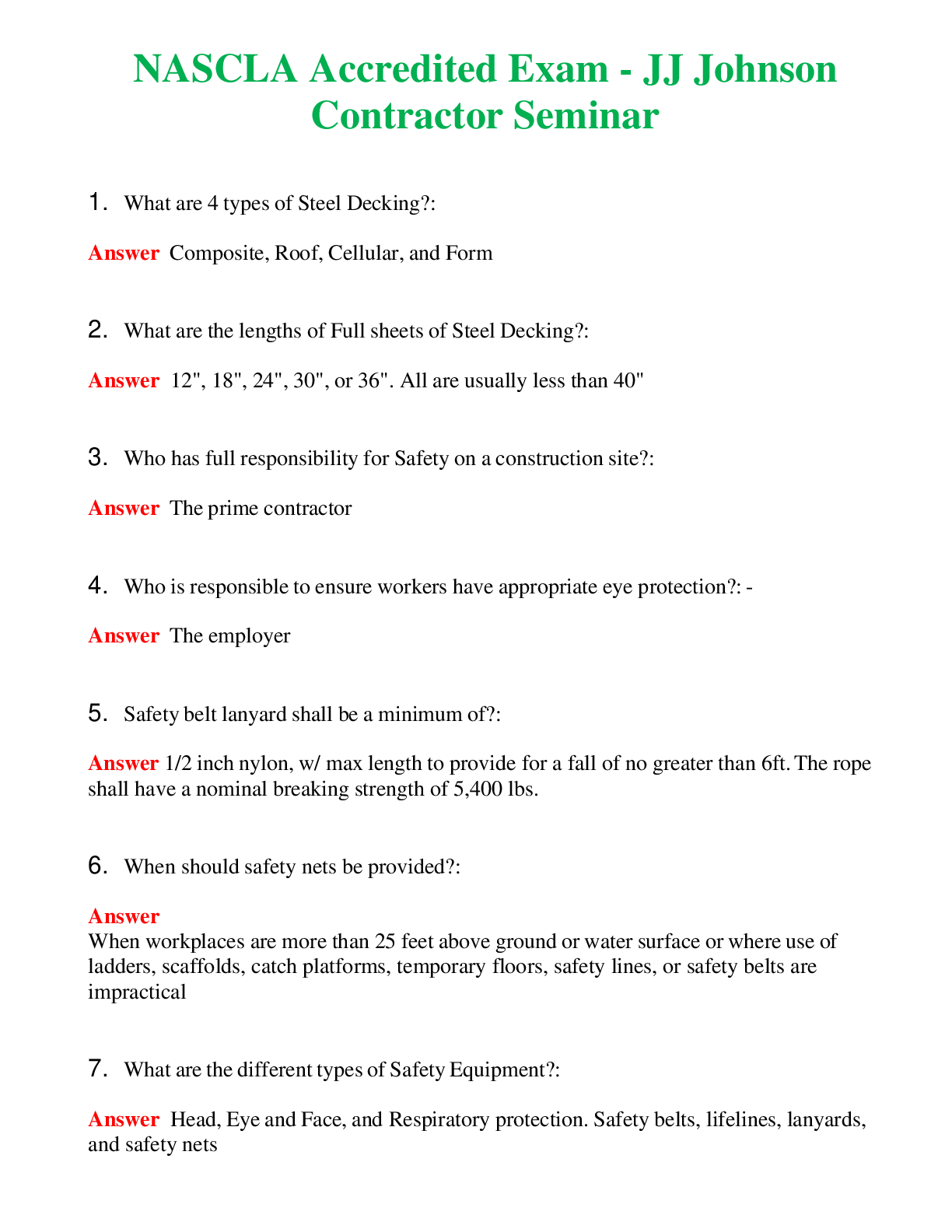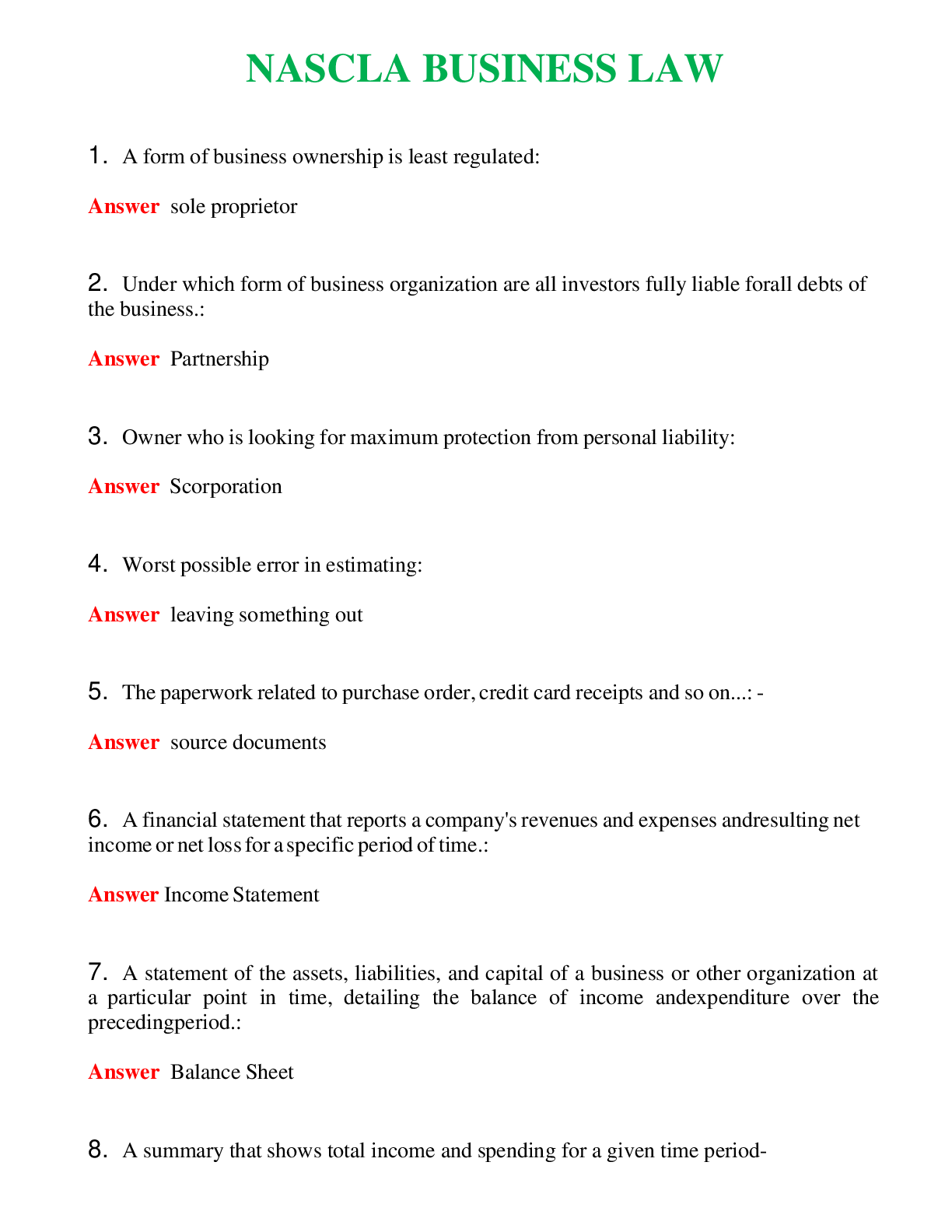MCCN Exam 2 Part 2 Exam Questions & Answers, with Verified Solutions
Document Content and Description Below
MCCN Exam 2 Part 2 Exam Questions & Answers, with Verified Solutions-Which statement describing physiologic jaundice is incorrect? a. Neonatal jaundice is common, but kernicterus is rare. b. The app ... earance of jaundice during the first 24 hours or beyond day 7 indicates a pathologic process. c. Because jaundice may not appear before discharge, parents need instruction on how to assess it and when to call for medical help. d. Breastfed babies have a lower incidence of jaundice. - ANS: D Breastfeeding is associated with an increased incidence of jaundice. Neonatal jaundice occurs in 60% of newborns; the complication called kernicterus is rare. Jaundice in the first 24 hours or that persists past day 7 is cause for medical concern. Parents need to know how to assess for jaundice in their newborn. The cheese-like, whitish substance that fuses with the epidermis and serves as a protective coating is called: a. vernix caseosa. b. surfactant. c. caput succedaneum. d. acrocyanosis. - ANS: A This protection, vernix caseosa, is needed because the infant's skin is so thin. Surfactant is a protein that lines the alveoli of the infant's lungs. Caput succedaneum is the swelling of the tissue over the presenting part of the fetal head. Acrocyanosis is cyanosis of the hands and feet that results in a blue coloring. What marks on a baby's skin may indicate an underlying problem that requires notification of a physician? a. Mongolian spots on the back b. Telangiectatic nevi on the nose or nape of the neck c. Petechiae scattered over the infant's body d. Erythema toxicum anywhere on the body - ANS: C Petechiae (bruises) scattered over the infant's body should be reported to the pediatrician because they may indicate underlying problems. Mongolian spots are bluish-black spots that resemble bruises but fade gradually over months and have no clinical significance. Telangiectatic nevi (stork bites, angel kisses) fade by the second year and have no clinical significance. Erythema toxicum is an appalling-looking rash, but it has no clinical significance and requires no treatment. NURSING An examiner who discovers unequal movement or uneven gluteal skinfolds during the Ortolani maneuver would then: a. tell the parents that one leg may be longer than the other, but they will equal out by the time the infant is walking. b. alert the physician that the infant has a dislocated hip. c. inform the parents and physician that molding has not taken place. d. suggest that, if the condition does not change, surgery to correct vision problems may be needed. - ANS: B The Ortolani maneuver is a technique for checking hip integrity. Unequal movement suggests that the hip is dislocated. The physician should be notified. One reason the brain is vulnerable to nutritional deficiencies and trauma in early infancy is the: a. incompletely developed neuromuscular system. b. primitive reflex system. c. presence of various sleep-wake states. d. cerebellum growth spurt. - ANS: D The vulnerability of the brain likely is to the result of the cerebellum growth spurt. The neuromuscular system is almost completely developed at birth. The reflex system is not relevant. The various sleep-wake states are not relevant. The nurse caring for the newborn should be aware that the sensory system least mature at the time of birth is: a. vision. b. hearing. c. smell. d. taste. - ANS: A The visual system continues to develop for the first 6 months. As soon as the amniotic fluid drains from the ear (minutes), the infant's hearing is similar to that of an adult. Newborns have a highly developed sense of smell. The newborn can distinguish and react to various tastes. During life in utero, oxygenation of the fetus occurs through transplacental gas exchange. When birth occurs, four factors combine to stimulate the respiratory center in the medulla. The initiation of respiration then follows. Which is not one of these essential factors? a. Chemical b. Mechanical c. Thermal d. Psychologic - ANS: D Psychologic factor is not one of the essential factors in the initiation of breathing; the fourth factor is sensory. The sensory factors include handling by the provider, drying by the nurse, lights, smells, and sounds. Chemical factors are essential for the initiation of breathing. During labor, decreased levels of oxygen and increased levels of carbon dioxide seem to have a cumulative effect that is involved in the initiation of breathing. Clamping of the cord may also contribute to the start of respirations. Prostaglandins are known to inhibit breathing, and clamping of the cord results in a drop in the level of prostaglandins. Mechanical factors are also necessary to initiate respirations. As the infant passes through the birth canal, the chest is compressed. With birth the chest is relaxed, which allows for negative intrathoracic pressure that encourages air to flow into the lungs. The profound change in temperature between intrauterine and extrauterine life stimulates receptors in the skin to communicate with the receptors in the medulla. This also contributes to the initiation of breathing. A collection of blood between the skull bone and its periosteum is known as a cephalhematoma. To reassure the new parents whose infant develops such a soft bulge, it is important that the nurse be aware that this condition: a. may occur with spontaneous vaginal birth. b. happens only as the result of a forceps or vacuum delivery. c. is present immediately after birth. d. will gradually absorb over the first few months of life. - ANS: A Bleeding may occur during a spontaneous vaginal delivery as a result of the pressure against the maternal bony pelvis. The soft, irreducible fullness does not pulsate or bulge when the infant cries. Low forceps and other difficult extractions may result in bleeding. However, cephalhematomas can also occur spontaneously. The swelling may appear unilaterally or bilaterally and is usually minimal or absent at birth. It increases over the first 2 to 3 days of life. Cephalhematomas disappear gradually over 2 to 3 weeks. A less common condition results in calcification of the hematoma, which may persist for months. A nursing student is helping the nursery nurses with morning vital signs. A baby born 10 hours ago by cesarean section is found to have moist lung sounds. What is the best interpretation of these data? a. The nurse should notify the pediatrician stat for this emergency situation. b. The neonate must have aspirated surfactant. c. If this baby was born vaginally, it could indicate a pneumothorax. d. The lungs of a baby delivered by cesarean section may sound moist for 24 hours after birth. - ANS: D The condition will resolve itself within a few hours. For this common condition of newborns, surfactant acts to keep the expanded alveoli partially open between respirations. In vaginal births, absorption of remaining lung fluid is accelerated by the process of labor and delivery. Remaining lung fluid will move into interstitial spaces and be absorbed by the circulatory and lymphatic systems. This is a particularly common condition for infants delivered by cesarean section. Surfactant is produced by the lungs, so aspiration is not a concern. Nurses can prevent evaporative heat loss in the newborn by: a. drying the baby after birth and wrapping the baby in a dry blanket. b. keeping the baby out of drafts and away from air conditioners. c. placing the baby away from the outside wall and the windows. d. warming the stethoscope and the nurse's hands before touching the baby. - ANS: A Because the infant is wet with amniotic fluid and blood, heat loss by evaporation occurs quickly. Heat loss by convection occurs when drafts come from open doors and air currents created by people moving around. If the heat loss is caused by placing the baby near cold surfaces or equipment, it is referred to as a radiation heat loss. Conduction heat loss occurs when the baby comes in contact with cold objects or surfaces. A first-time dad is concerned that his 3-day-old daughter's skin looks "yellow." In the nurse's explanation of physiologic jaundice, what fact should be included? a. Physiologic jaundice occurs during the first 24 hours of life. b. Physiologic jaundice is caused by blood incompatibilities between the mother and infant blood types. c. The bilirubin levels of physiologic jaundice peak between 72 to 96 hours of life. d. This condition is also known as "breast milk jaundice." - ANS: C Physiologic jaundice becomes visible when the serum bilirubin reaches a level of 5 mg/dL or greater, which occurs when the baby is approximately 3 days old. This finding is within normal limits for the newborn. Pathologic jaundice occurs during the first 24 hours of life. Pathologic jaundice is caused by blood incompatibilities, causing excessive destruction of erythrocytes, and must be investigated. Breast milk jaundice occurs in one third of breastfed infants at 2 weeks and is caused by an insufficient intake of fluids. Cardiovascular changes that cause the foramen ovale to close at birth are a direct result of: a. increased pressure in the right atrium. b. increased pressure in the left atrium. c. decreased blood flow to the left ventricle. d. changes in the hepatic blood flow. - ANS: B With the increase in the blood flow to the left atrium from the lungs, the pressure is increased, and the foramen ovale is functionally closed. The pressure in the right atrium decreases at birth. It is higher during fetal life. Blood flow increases to the left ventricle after birth. The hepatic blood flow changes, but that is not the reason for the closure of the foramen ovale. [Show More]
Last updated: 1 year ago
Preview 5 out of 60 pages

Loading document previews ...
Buy this document to get the full access instantly
Instant Download Access after purchase
Buy NowInstant download
We Accept:

Reviews( 0 )
$15.50
Can't find what you want? Try our AI powered Search
Document information
Connected school, study & course
About the document
Uploaded On
Dec 30, 2024
Number of pages
60
Written in
All
Additional information
This document has been written for:
Uploaded
Dec 30, 2024
Downloads
0
Views
24


